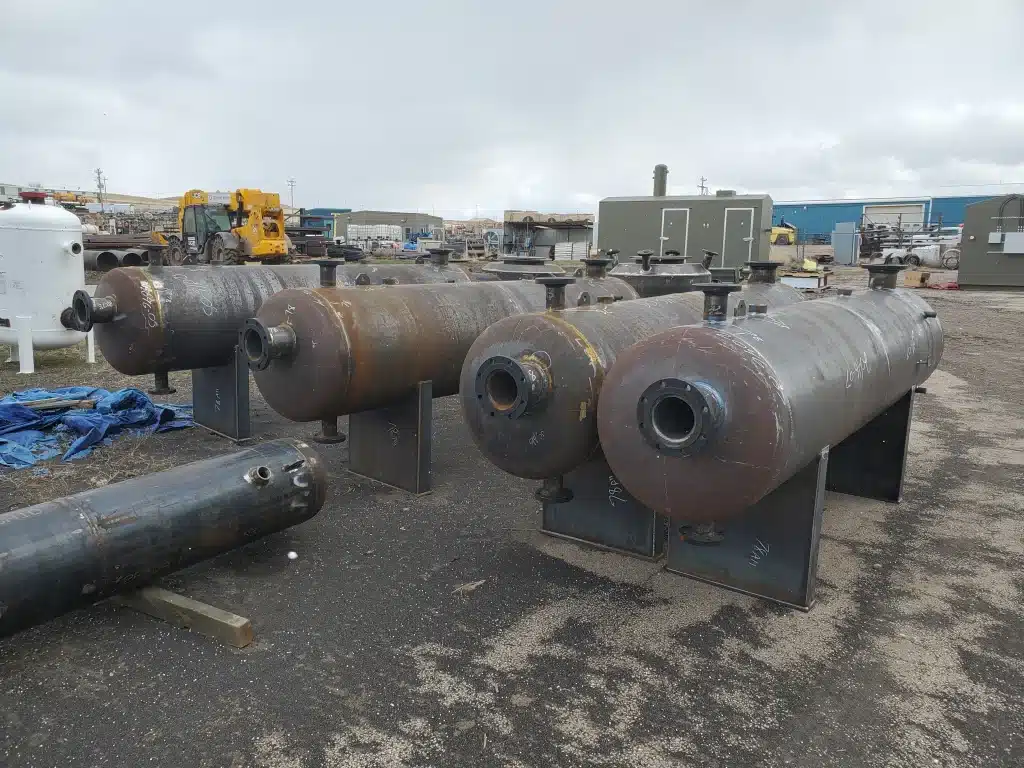
Pressure tanks are smaller, simpler containers designed to store and regulate fluids or gases at moderate pressures, often for residential or light commercial use. Pressure vessels are more robust, industrial-grade systems built to handle high pressures and extreme conditions, with strict safety standards and broader applications.
The differences between a Pressure Tank and a Pressure Vessel
In the intricate world of industries, terminology matters. It’s not just about semantics; it can be a matter of safety, efficiency, and regulatory compliance. Two terms that often get interchanged but have critical distinctions are “pressure tank” and “pressure vessel.” As someone with over 8 years of experience in SEO and a deep understanding of keyword optimization, I’m here to guide you through this terminology maze.
In this article, we’ll delve into the definitions, historical context, and most importantly, the key differences between pressure tanks and pressure vessels. Whether you’re a seasoned professional in the industry or just getting started, understanding these terms is vital. It affects the way you work, the safety of your operations, and even the bottom line of your business.
Definition of Terms
Pressure Tank
A pressure tank, often referred to as a “pressure vessel” by mistake, is a closed container designed to hold gases or liquids at a pressure different from the ambient pressure. These tanks are meticulously engineered to withstand the internal pressure created by the contents they house, making them a cornerstone in a wide range of applications across various industries.
Common Uses and Industries:
Pressure tanks find application in numerous sectors, including but not limited to:
Water Supply Systems:
In domestic, commercial, and industrial contexts, pressure tanks help maintain consistent water pressure, ensuring efficient water distribution.
Petrochemical Industry:
Pressure tanks store and transport a variety of volatile substances such as petroleum, chemicals, and gases.
Agriculture:
In agricultural irrigation systems, pressure tanks are instrumental in delivering water to fields and crops with optimal pressure.
Food and Beverage:
They are used for the storage and transport of liquids like wine, beer, and dairy products.
Manufacturing:
Pressure tanks are integral in manufacturing processes, where they store and dispense materials efficiently.
Pressure Vessel
A pressure vessel is a closed vessel designed to contain and safely withstand the pressure differential between its internal contents and the external environment. These vessels are engineered with precision and adhere to rigorous standards and regulations to ensure the safe storage, transportation, or processing of various substances, including gases and liquids under pressure.
Key Characteristics of Pressure Vessels:
Pressure Resistance:
Pressure vessels are built to endure high internal pressures without compromising their structural integrity.
Robust Construction:
They are typically constructed using materials that can withstand the stresses associated with pressure differentials, such as steel, alloy metals, or composite materials.
Diverse Applications:
Pressure vessels serve diverse purposes across industries, including storing compressed gases, chemical reactions, and industrial processes.
Safety Standards:
The design and manufacturing of pressure vessels must adhere to strict safety codes and standards, often set by organizations like the American Society of Mechanical Engineers (ASME).
Industries and Applications:
Pressure vessels are prevalent in various industries, including:
Chemical Processing:
Used for reactions, storage, and transport of chemicals under pressure.
Oil and Gas:
Employed for the storage and transportation of petroleum, natural gas, and other hydrocarbons.
Energy Production:
Utilized in power plants for steam generation and nuclear reactors.
Pharmaceuticals:
Important for pharmaceutical manufacturing processes.
Food Processing:
Used in the food industry for sterilization and preservation processes.
Historical Background
Pressure Tanks:
- The concept of pressure tanks can be traced back to ancient civilizations. Early civilizations, such as the Egyptians and Greeks, used rudimentary pressure vessels made of wood and leather for storing liquids. These vessels were often used in irrigation systems to regulate water flow.
- However, it wasn’t until the Industrial Revolution in the 18th and 19th centuries that pressure tanks started to take on more advanced forms. With advancements in metallurgy and engineering, manufacturers began crafting sturdier containers capable of withstanding higher pressures. This innovation paved the way for the use of pressure tanks in various industrial applications, including steam engines and early locomotives.
Pressure Vessels:
- The history of pressure vessels is closely tied to advancements in industrial processes and the need for handling gases and liquids under extreme conditions. One of the earliest instances of pressure vessels can be attributed to the development of steam boilers during the late 17th century.
- The Industrial Revolution marked a significant turning point in the evolution of pressure vessels. The demand for efficient steam engines and the growth of industries such as mining, textiles, and transportation drove engineers to develop more reliable and robust pressure vessels. This period saw the introduction of safety valves and the establishment of safety standards, laying the foundation for modern pressure vessel design and regulations.
In the 20th century, the American Society of Mechanical Engineers (ASME) played a pivotal role in standardizing the design, construction, and inspection of pressure vessels. ASME’s Boiler and Pressure Vessel Code, first published in 1914, continues to be a globally recognized standard for pressure vessel safety. - Today, pressure tanks and pressure vessels are integral components in numerous industries, from energy production to chemical processing. Their historical evolution, from early containers to highly engineered systems, underscores the critical role they play in modern industrial processes.
Key Differences Between Pressure Tanks and Pressure Vessels
Design and Construction
While pressure tanks and pressure vessels both serve the purpose of containing substances under pressure, their design and construction exhibit distinctive characteristics:
Pressure Tank:
Simplicity of Design:
Pressure tanks typically feature a simpler design compared to pressure vessels. They are often cylindrical or spherical in shape and may have a single, seamless wall.
Lower Pressure Ratings:
Pressure tanks are engineered to withstand lower pressure differentials when compared to pressure vessels. They are suitable for applications where pressures are relatively moderate.
Lighter Materials:
Pressure tanks are engineered to withstand lower pressure differentials when compared to pressure vessels. They are suitable for applications where pressures are relatively moderate.
Domestic and Small-Scale Use:
They are frequently found in residential and small-scale commercial applications, such as water systems and air compressors.
Lower Cost:
Due to their simpler construction and lower pressure ratings, pressure tanks are generally more cost-effective than pressure vessels.
Pressure Vessel:
Complex Engineering:
Pressure vessels are engineered with a focus on complexity and precision. They have intricate designs to ensure safety and performance under extreme pressures and conditions.
High-Pressure Ratings:
Pressure vessels are designed to withstand significantly higher pressure differentials, making them suitable for applications involving high-pressure gases or volatile substances.
Heavy-Duty Materials:
Pressure vessels are constructed using heavy-duty materials like thick-walled steel or alloy metals, which can handle the stresses of high-pressure environments.
Industrial and Specialized Use:
They are predominantly used in industrial settings and specialized processes, including chemical manufacturing, power generation, and oil and gas refining.
Stringent Safety Standards:
Pressure vessels are subject to strict safety standards and regulations, such as those outlined in the ASME Boiler and Pressure Vessel Code, to ensure their integrity and safety.
Functionality
Purpose:
Pressure Tank:
Primarily used for storing and regulating the pressure of gases or liquids, pressure tanks are often integrated into systems to provide a constant and controlled flow of their contents. They play a crucial role in maintaining pressure levels and ensuring a consistent supply of fluids.
Pressure Vessel:
Pressure vessels are designed for a broader range of functions, including but not limited to storing, transporting, and processing substances under pressure. They are more versatile and can handle a wide variety of applications, such as chemical reactions, heat exchange, and phase changes.
Continuous vs. Batch Operations:
Pressure Tank:
Typically used in continuous operations, where substances are consistently supplied or withdrawn at a controlled rate. They help maintain a steady pressure throughout the process.
Pressure Vessel:
Often employed in batch processes, where materials are loaded, processed, and then unloaded. Pressure vessels can accommodate varying pressures and temperatures, making them suitable for diverse applications.
Regulation and Control:
Pressure Tank:
Primarily focuses on maintaining a specific pressure level to ensure a constant flow. They may incorporate pressure switches or control systems to achieve this.
Pressure Vessel:
Designed with greater flexibility, pressure vessels can handle varying pressures and temperature conditions. They often require more intricate control and safety systems to manage complex processes effectively.
Examples of Applications:
Pressure Tank:
Common applications include water supply systems (pressure tanks in well systems), pneumatic systems (air compressors), and hydraulic systems.
Pressure Vessel:
Widely used in industries such as chemical manufacturing (for reactions under pressure), oil and gas (for storage and transportation of hydrocarbons), and energy production (steam generators and nuclear reactors).
Safety Considerations:
Pressure Tank:
While safety is paramount, pressure tanks are often associated with simpler safety measures due to their more straightforward function. Proper maintenance, pressure relief valves, and pressure switches are common safety features.
Pressure Vessel:
Safety is a critical concern due to the diverse and sometimes hazardous processes they handle. Pressure vessels must adhere to stringent safety standards, including regular inspections, relief devices, and emergency shutdown systems.
Safety Protocols
Design Pressure and Safety Margins:
Pressure Tanks:
Pressure tanks are typically designed with safety margins that allow for temporary pressure fluctuations. However, these safety margins are often not as extensive as those in pressure vessels.
Pressure Vessels:
Pressure vessels are engineered with more substantial safety margins to accommodate significant pressure differentials and potential overpressure situations. This design ensures a higher level of safety during operation.
Safety Devices:
Pressure Tanks:
Safety features in pressure tanks often include pressure relief valves or pressure switches that trigger when pressure exceeds a predetermined threshold. These mechanisms help prevent catastrophic failures but may not offer as comprehensive protection as those in pressure vessels.
Pressure Vessels:
Pressure vessels are equipped with a range of safety devices, including multiple pressure relief valves, rupture disks, and overpressure protection systems. These redundancies ensure a higher level of safety, especially in critical applications.
Regulatory Compliance:
Pressure Tanks:
While pressure tanks must adhere to safety standards, the regulations and compliance requirements are often less stringent compared to those for pressure vessels.
Pressure Vessels:
Pressure vessels are subject to rigorous safety codes and standards, such as the ASME Boiler and Pressure Vessel Code. Compliance with these standards is mandatory, with regular inspections and certifications to ensure safety.
Operating Conditions:
Pressure Tanks:
Pressure tanks are generally used in applications where pressure differentials are within a moderate range, making them suitable for less critical processes.
Pressure Vessels:
Pressure vessels are designed to withstand extreme pressure conditions, making them suitable for high-pressure and high-temperature applications, including those in the petrochemical and nuclear industries.
Inspection and Maintenance:
Pressure Tanks:
While maintenance is essential for pressure tanks, inspection intervals may be less frequent than those for pressure vessels.
Pressure Vessels:
Pressure vessels require regular inspections by certified inspectors to ensure compliance with safety standards. The inspection frequency is often dictated by industry-specific regulations.
Standards and Regulations
American Society of Mechanical Engineers (ASME) Standards:
Pressure Tanks:
While pressure tanks must adhere to certain safety and construction standards, such as those outlined in ASME’s Boiler and Pressure Vessel Code (BPVC) Section VIII, Division 1, the requirements are often less stringent than those for pressure vessels.
Pressure Vessels:
Pressure vessels are subject to comprehensive ASME BPVC standards. Section VIII of the code specifically addresses the design, construction, inspection, and testing of pressure vessels. ASME certification is a hallmark of safety and compliance for pressure vessels.
National Board Inspection Code (NBIC):
Pressure Tanks:
Pressure tanks may be subject to inspection and registration requirements under the NBIC. These requirements vary by jurisdiction and application.
Pressure Vessels:
Pressure vessels are typically required to adhere to the NBIC for inspection, repair, and maintenance, ensuring their continued safe operation.
Jurisdictional Regulations:
Pressure Tanks:
Regulations governing pressure tanks may vary depending on their application, size, and location. Local, state, and national authorities may have specific requirements.
Pressure Vessels:
Pressure vessels are often subject to more stringent jurisdictional regulations due to their critical nature. Authorities may require permitting, regular inspections, and compliance with applicable codes and standards.
Industry-Specific Standards:
Pressure Tanks:
Different industries may have their own standards and guidelines for pressure tank design and operation. These standards should be consulted for specific applications.
Pressure Vessels:
Pressure vessels used in industries such as oil and gas, nuclear, or chemical processing must adhere to industry-specific standards and guidelines to ensure safety and compliance.
Material Specifications:
Pressure Tanks:
The choice of materials for pressure tanks must align with industry standards and the specific application’s requirements, considering factors such as corrosion resistance and pressure tolerance.
Pressure Vessels:
Pressure vessels must use materials that meet stringent specifications to ensure structural integrity and resistance to the substances they contain.
Common Misconceptions and Mistakes
Interchanging Terminology:
Misconception:
One of the most prevalent errors is the casual interchangeability of the terms “pressure tank” and “pressure vessel.” Many people assume they refer to the same thing.
Mistake:
Failing to distinguish between these two terms can lead to misunderstandings, miscommunication, and, more critically, the selection of the wrong equipment for a specific application.
Neglecting Safety Features:
Misconception:
Some assume that safety features like pressure relief valves and rupture disks are optional or unnecessary.
Mistake:
Neglecting safety features can result in catastrophic failures, endangering personnel, property, and the environment. These safety devices are essential and should never be omitted or bypassed.
Underestimating Inspection Requirements:
Misconception:
Operators may underestimate the frequency and importance of inspections for both pressure tanks and pressure vessels.
Mistake:
Regular inspections are critical to identifying wear and tear, corrosion, and other potential issues that could compromise the integrity of these components. Neglecting inspections can lead to accidents and non-compliance with regulatory standards.
Overlooking Material Compatibility:
Misconception:
Some assume that any material can be used for pressure tanks and pressure vessels without considering the compatibility with the substances they will contain.
Mistake:
Using incompatible materials can lead to chemical reactions, corrosion, and material failure. It’s essential to choose materials that are resistant to the substances they will handle.
Ignoring Regulatory Compliance:
Misconception:
Businesses may believe that adhering to industry standards and regulations is optional or an unnecessary expense.
Mistake:
Ignoring regulatory compliance can result in legal consequences, fines, and compromised safety. Compliance with standards is not only a legal requirement but also essential for ensuring the safety of personnel and equipment.
Neglecting Maintenance:
Misconception:
Maintenance for pressure tanks and pressure vessels may be viewed as an unnecessary cost rather than an investment in longevity and safety.
Mistake:
Neglecting maintenance can lead to premature equipment failure, costly repairs, and potentially dangerous situations. Routine maintenance is crucial for extending the lifespan of these components.
Importance of Proper Selection
Safety Assurance:
- Proper selection of pressure equipment ensures the safety of personnel and the surrounding environment. Selecting the wrong equipment or neglecting safety considerations can lead to catastrophic accidents, injuries, and property damage.
Regulatory Compliance:
- Regulatory bodies mandate the use of specific equipment and adherence to industry standards for certain applications. Proper selection ensures compliance with these regulations, reducing the risk of legal liabilities, fines, and shutdowns.
Operational Efficiency:
- The right equipment enhances operational efficiency by ensuring that processes run smoothly and effectively. Incorrectly chosen equipment can lead to downtime, maintenance issues, and increased operational costs.
Cost Management:
- Proper selection takes into account factors such as material compatibility, maintenance requirements, and lifespan. Choosing the right equipment upfront can lead to cost savings over the long term, reducing the need for frequent repairs or replacements.
Environmental Impact:
- Incorrect equipment selection can have environmental repercussions, especially in industries dealing with hazardous substances. Properly selected equipment minimizes the risk of leaks, spills, and environmental contamination.
Longevity and Reliability:
- The right equipment is designed to withstand the specific demands of an application. Properly selected pressure tanks and pressure vessels tend to have longer lifespans and greater reliability, reducing downtime and replacement costs.
Process Optimization:
- Equipment that is well-suited to its intended purpose can optimize industrial processes. This can lead to increased productivity, improved product quality, and a competitive edge in the market.
Risk Mitigation:
- Proper selection mitigates risks associated with pressure-related incidents, such as explosions or leaks. It provides a crucial layer of protection against potential disasters.
Reputation and Trust:
- Demonstrating a commitment to safety and responsible equipment selection enhances an organization’s reputation. It fosters trust with clients, partners, and regulatory authorities.
Lifecycle Considerations:
- Properly selected equipment takes into account the entire lifecycle of the system, from design and installation to maintenance and eventual decommissioning. This holistic approach ensures the equipment’s sustainability and functionality throughout its service life.
Maintenance and Longevity
Safety Assurance:
- Regular maintenance helps identify and address potential safety hazards, such as corrosion, leaks, or wear and tear. Addressing these issues promptly prevents accidents and ensures the safety of personnel.
Equipment Longevity:
- Maintenance procedures, such as cleaning, inspections, and corrosion prevention, significantly extend the lifespan of pressure tanks and pressure vessels. This translates to cost savings by reducing the need for premature replacements.
Operational Efficiency:
- Well-maintained equipment operates more efficiently, reducing energy consumption and operational costs. Properly functioning pressure equipment minimizes downtime and disruptions to industrial processes.
Regulatory Compliance:
- Many industries have strict regulatory requirements regarding equipment maintenance and inspections. Compliance with these regulations is essential to avoid fines, legal liabilities, and operational interruptions.
Cost-Effective Repairs:
- Routine maintenance allows for the early detection of issues that can be addressed through cost-effective repairs rather than costly replacements. This helps manage maintenance budgets more effectively.
Environmental Impact:
- Regular maintenance reduces the risk of leaks and spills, minimizing the environmental impact associated with pressure-related incidents.
Product Quality:
- In industries where pressure equipment is used in manufacturing processes, well-maintained equipment contributes to consistent product quality and fewer production interruptions.
Preventing Catastrophic Failures:
- Neglecting maintenance increases the risk of catastrophic equipment failures, which can result in significant damage, injuries, and operational downtime.
Maintenance Best Practices:
Inspection and Testing:
- Regularly inspect equipment for signs of wear, corrosion, and damage. Conduct non-destructive testing as needed to assess the integrity of the equipment.
Cleaning and Corrosion Control:
- Clean pressure tanks and pressure vessels regularly to remove contaminants and reduce the risk of corrosion. Apply protective coatings or liners as necessary.
Pressure Relief Valve Checks:
- Ensure that pressure relief valves are functioning correctly. Test and replace them as needed to maintain safety.
Documentation:
- Maintain detailed records of maintenance activities, inspections, and repairs. This documentation is often required for regulatory compliance.
Training:
- Train personnel in maintenance procedures and safety protocols to ensure that maintenance tasks are carried out correctly and safely.
Schedule Maintenance:
- Develop a maintenance schedule that includes routine inspections, preventive maintenance, and planned shutdowns for more extensive maintenance tasks.
Need a reliable partner?
Red River specializes in the design and manufacturing of pressure vessels. We also fabricate related items such as prefabricated spools and skid packages.
Reach Out to us today and experience the Red River difference. Where American Made and American Values come together, we care more.
FAQ: Pressure Tanks vs. Pressure Vessels
What is the difference between a pressure tank and a pressure vessel?
A pressure tank is a type of pressure vessel, but the term “pressure tank” often refers to smaller, more specific applications like water storage or expansion tanks in plumbing systems. Pressure vessels, a broader category, include a wide range of containers designed to hold gases or liquids at high pressures, encompassing everything from industrial reactors to storage tanks. The key difference lies in their application and size, with pressure tanks typically being used for more specialized, often smaller-scale operations.
Are the materials used for pressure tanks and pressure vessels different?
The materials used for pressure tanks and pressure vessels can be similar, including carbon steel, stainless steel, and composite materials, chosen for their strength and resistance to pressure and corrosion. The specific material selected depends on the tank or vessel’s intended use, the substances it will contain, and the operating environment, rather than the distinction between being a tank or a vessel.
How do the design standards for pressure tanks and pressure vessels compare?
Both pressure tanks and pressure vessels must adhere to strict design standards to ensure safety and reliability. In the United States, the ASME Boiler and Pressure Vessel Code (BPVC) is a common standard for both, dictating the design, fabrication, inspection, and testing requirements. The specific standards and regulations can vary based on the tank or vessel’s size, pressure rating, and application, but the fundamental safety principles apply universally.
Can pressure tanks be used interchangeably with pressure vessels for any application?
While pressure tanks are a subset of pressure vessels, they cannot always be used interchangeably. Pressure tanks are often designed for specific applications, such as hot water systems or air compression, and may not be suitable for the broader range of applications that larger pressure vessels are designed for, such as chemical processing or gas storage. The suitability depends on the design specifications, pressure and temperature requirements, and the chemical compatibility of the materials.
What are the common applications for pressure tanks and pressure vessels?
Pressure tanks are commonly used in water heating systems, compressed air storage, and in HVAC systems as expansion tanks. Pressure vessels have a broader range of applications, including but not limited to, chemical manufacturing, petroleum refining, and power generation, where they serve as reactors, storage tanks, and separators.
Key Takeaways
Pressure tanks are typically simpler, lower-pressure, and used in domestic or small-scale industrial applications, while pressure vessels handle high pressures in industrial settings.
Pressure vessels require heavy-duty materials, complex designs, and strict adherence to safety codes such as ASME standards.
Proper selection, maintenance, and inspection of both are critical to operational efficiency, safety, and regulatory compliance.
Misunderstanding the differences can lead to equipment failure, safety risks, and non-compliance with industry regulations.
Related Blog Post
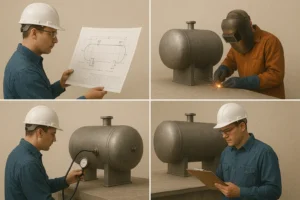
Pressure Vessel Design & Engineering: Concept to Launch
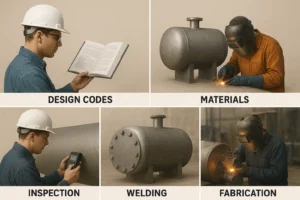
What is Pressure Vessel Design and Engineering: Code-Ready Guide
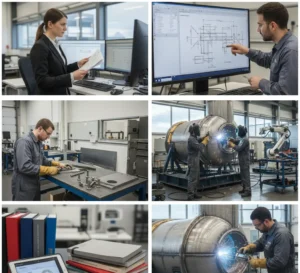
What are the Key Factors in Pressure Vessel Engineering
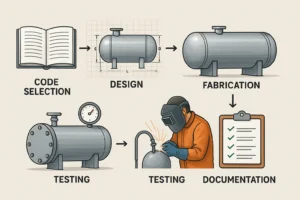
How Do You Design a Pressure Vessel: A Step-By-Step Guide
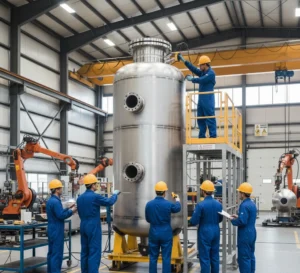
What is Pressure Vessel Fabrication and Manufacturing
About Author

